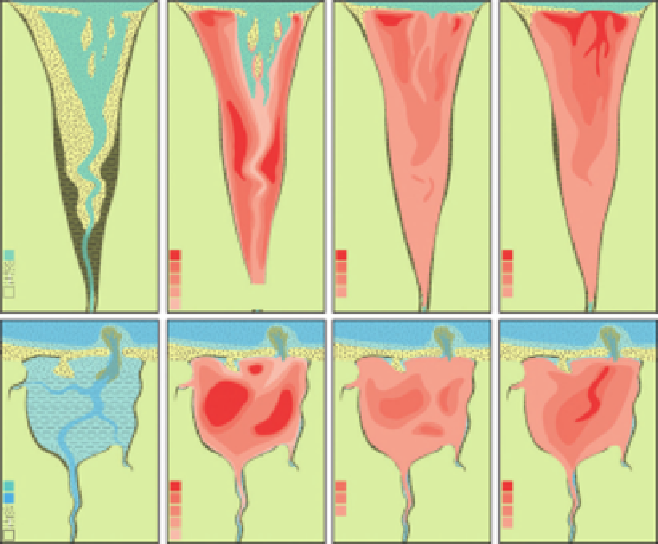Environmental Engineering Reference
In-Depth Information
Plan view
Bioturbation index
Diversity of infauna
Largest burrow diameter
Subtidal
Bl = 5-6
>
10
>
100 mm
>
50% sand
Bl = 4
Bl = 3
Bl = 2
Bl = 1
7-9
4-6
1-3
26-100 mm
<
50% sand
6-25 mm
Interfluve
* no shading indicates
generally unburrowed
<
5 mm
Subtidal (
<
1m)
Subtidal (
>
1m)
Bl = 5-6
Bl = 4
Bl = 3
Bl = 2
Bl = 1
7-9
4-6
1-3
>
100 mm
26-100 mm
6-25 mm
>
50% sand
<
50% sand
<
5 mm
Interfluve
FIGURE 3
Conceptual framework for the distribution of trace-fossil characteristics in mixed-
energy to tide-dominated (top row) and wave-dominated (bottom row) estuary settings. Broadly
speaking, the mixed to tidal framework is based on personal observations and data from the Willapa
and Tillamook bays, the Ogeechee River estuary and the Bay of Fundy. The wave-dominated frame-
work is based on the Kouchibouguac-River estuary. These distributions are most sensitive to the
amount of freshwater flux into the system: a higher fluvial discharge can significantly freshen
the estuary.
salinity and that their product provides a logarithmic relationship. Although
similar efforts have not been attempted in the stratigraphic record, this type
of data-intensive analysis has excellent potential for the identification of
various marginal-marine settings.
Regarding criteria 2 and 3, it can be challenging to establish what is meant by
the terms “diminutive trace fossil” and “low-diversity assemblage”. In practice,
it is difficult to recognize trends in diminution and diversity, unless a fully
marine baseline can be established from contemporaneous rocks in the associ-
ated sedimentary basin (cf.
MacEachern and Gingras, 2007
). In other words,
workers must establish a case for relatively lower salinity as opposed to deter-
mining absolute salinity. This practice is important. The basin from which the
“marine” ichnological suite is defined, may itself have contained brackish water







Search WWH ::

Custom Search